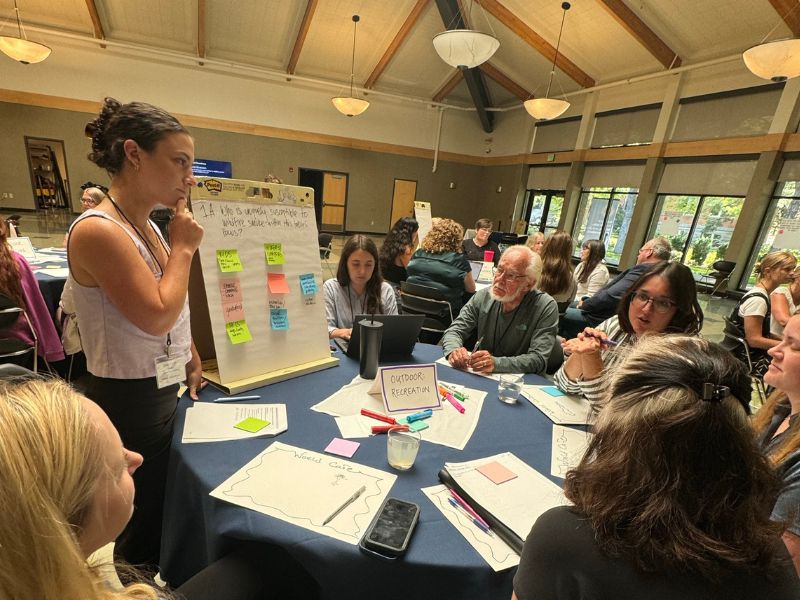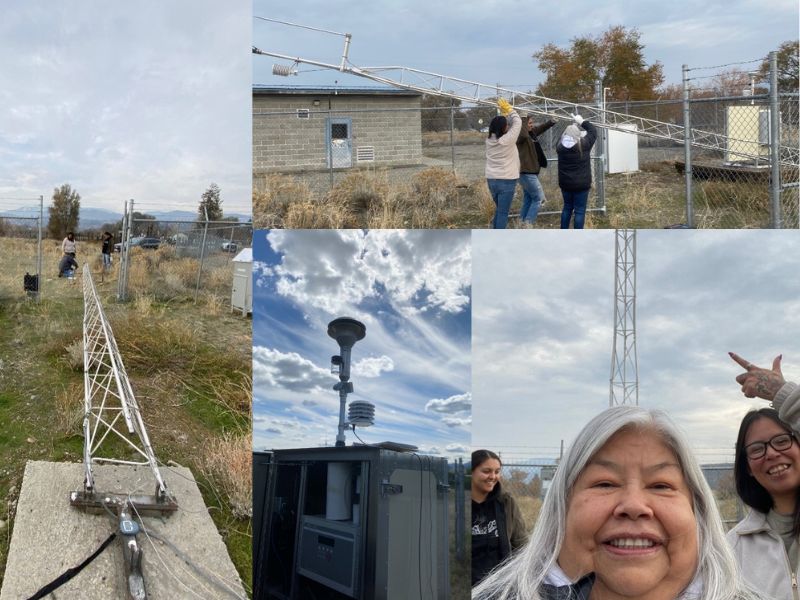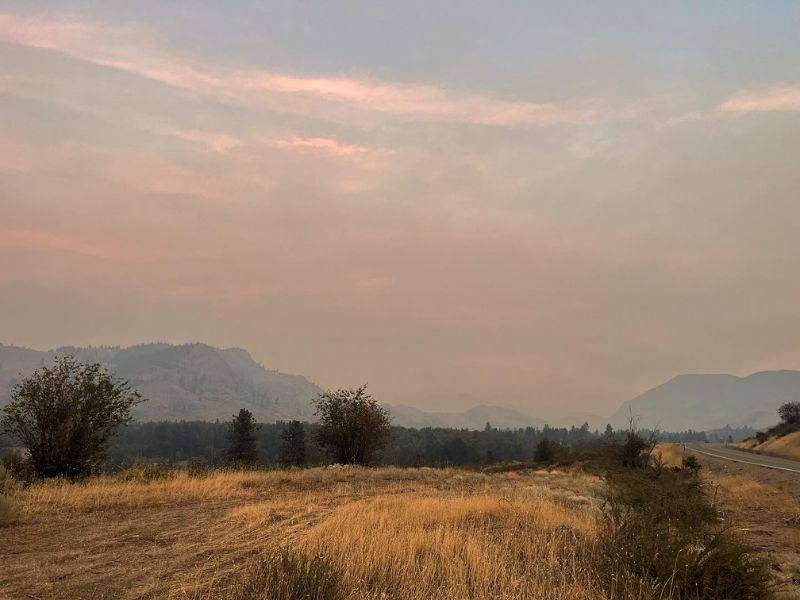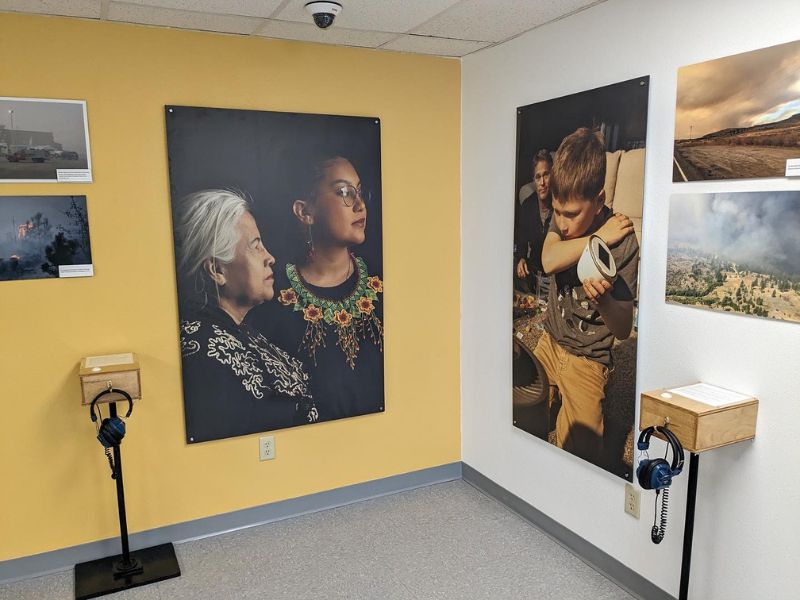
Community members at the 2024 Smoke Ready Spokane Symposium
All across Washington, community leaders are working tirelessly to help people manage the dangers of wildfire smoke. This Smoke Ready week, we share the stories of three incredible Ecology partners.
Kathy Moses, Okanogan County
Kathy Moses remembers the Chuweah Creek Fire well. It burned close to her house, and the ground was seared black where lightning ignited the grass. That fire “almost burned the town of Nespelem up,” she recalled.
All told, the 2021 Chuweah Creek Fire burned nearly 40,000 acres around the town of Nespelem, located on the Colville Reservation. The fire destroyed homes and structures. Some people had to euthanize burned animals. The town fell under thick, dark smoke as residents were forced to evacuate.
Moses, a longtime communications specialist for the Colville Tribes and public information officer at Mt. Tolman Fire Center, has helped communities prepare for, deal with, and recover from wildfires and smoke for her entire career. It’s human work, as much about providing support as providing information.
After the Chuweah Creek Fire, Moses, along with other Tribal programs and departments, invited local elementary schools to the location near the lightning strike for a field day. The students spread “seed bombs” in the charred soil and could soon see native plants coming back up, Moses said.
It was a meaningful experience for the children, many of whom had been evacuated from their homes. “They felt like they were helping Mother Earth,” Moses explained. “The kids are learning about fires a lot earlier now, and they want to do whatever they can to help.” Smoke from the 2015 Okanogan Complex Fire
During wildfires, Moses would connect regularly with community members to check on their physical and mental well-being. This meant sharing updates with evacuated residents, spending time with anxious families, and making sure people knew how to protect themselves from smoke.
Reminding people about the dangers of wildfire smoke has been a key part of Moses’s outreach work. She emphasizes the health risks to keep people vigilant, even in areas that are used to smoke. To this end, Moses has posted photos of recent smoke events in community spaces before wildfire season begins.
“If people can identify the place and remember what happened, it’s a real eye-catcher and reminds them — yeah, we’ve got to prepare for this,” she said. ORAP members install an air monitoring site
The devastating wildfires of 2015 — which burned nearly 300,000 acres — encouraged the Tribal air quality program and other community leaders to form the Okanogan River Airshed Partnership (ORAP). Partners include several local agencies, the Colville Tribes, Ecology’s office in Union Gap, and EPA. ORAP, which Moses helped organize until her recent retirement, takes on various projects designed to reduce fine particle pollution (PM2.5) in the Okanogan Valley.
Recent ORAP initiatives to build smoke readiness include giving out HEPA air purifiers to people with underlying health conditions and deploying Purple Air sensors to expand local air monitoring.
Dante Jester, Spokane
A hundred miles southeast of Okanogan County, Gonzaga University’s Climate Institute is also building smoke readiness through community collaboration. It all began when the Institute launched its Climate Resilience Project in 2022, a response to the previous year’s deadly Northwest heat dome. The heat dome was an extreme heat wave that affected much of Washington, Oregon, Idaho, British Columbia, northern California, and western Nevada from late June through mid-July 2021.
“We quickly realized that we couldn’t talk about heat and climate change without talking about wildfires and smoke, especially in urban areas,” said Dante Jester, climate resilience manager at the Climate Institute. This became even clearer in 2023, when two large wildfires hit Spokane County at the same time.
“We get bad fires almost every summer, but this was a new sort of hell,” Jester recalled. “You stepped outside and could barely see.” The fires were “a big wake-up call for a lot of people as far as air quality goes,” they said.
These wildfires led to the creation of the Spokane Community Resilience Collaborative (SCRC), a coalition of partners from government, healthcare, education, and local nonprofits. SCRC meets monthly to discuss community resilience strategies for heat and wildfire events.
A major goal of these meetings has been designing extreme heat and wildfire smoke plans for the city of Spokane. The recommendations in these plans will help the Climate Institute engage with partner organizations strategically and effectively.
Other SCRC smoke readiness projects include developing community resilience hubs — where people can go for clean air and learn about smoke safety — and distributing air purifiers to local families. The group is also conducting a community-wide survey to better understand how people in Spokane experience wildfire smoke, Jester said. Washington Department of Natural Resources presents at the Smoke Ready Spokane Symposium
The experiences of Spokane residents have guided much of SCRC’s air quality work. Last summer, SCRC assembled 40 community leaders from government, healthcare, and local Tribes for a Wildfire Smoke Symposium. The leaders shared the challenges their constituents face during smoke events and discussed solutions.
But SCRC hasn’t just been talking about solutions. They’ve been implementing them, too. At community centers that serve low-income neighborhoods, the group has installed air quality sensors and dashboards that display Air Quality Index (AQI) data and health information in real time. They also plan to install heat pumps and air filtration systems in hundreds of low-income homes. This will address the dangerous combination of heat and smoke that wildfire season brings. SCRC's AQI dashboards show real-time air quality data and health advice
Much of this work was to be funded by a $20 million grant from EPA — that is, until the grant was cancelled in May. The Climate Institute is now dealing with the loss of several federal grants. This money was promised to help the most vulnerable residents of a city where unhealthy air quality days have increased 580% since 2014, Jester said.
“We’re pulling out all the stops to find additional funding,” they noted. “We’re just telling everyone to continue the work, because we’ve got to keep saving lives, you know?”
The Climate Institute recently received a grant from Ecology’s overburdened communities grants, which will fund community engagement, portable air cleaners, and electric parks equipment to replace old diesel tools.
Liz Walker, Methow Valley
Back up in Okanogan County, Liz Walker is no stranger to losing federal funding. Walker has spent years helping to build Clean Air Methow, a longtime Ecology partner organization run by the Methow Valley Citizen’s Council (MVCC). Clean Air Methow is dedicated to improving air quality and reducing smoke impacts in the Methow Valley.
In addition to her work with Clean Air Methow, Walker advises other public health-related organizations in North Central Washington. Three of these groups — MVCC, the Chelan-Douglas Health District, and Wenatchee CAFÉ — lost EPA environmental justice grants over the last few months.
“All that funding was doing a ton of wildfire smoke preparedness and air quality work here, and it just evaporated,” Walker said. “But the fires aren’t going away, so we’ll figure out how to deal with it.”
Wildfire smoke in the Methow Valley (credit: Clean Air Methow)
Like in Spokane and the rest of Okanogan County, smoke is an urgent public health issue in the Methow Valley. “We’ve had summers with 40 consecutive days where you couldn’t see the sun, and the air quality never dipped below unhealthy,” said Walker. “Wildfire smoke is inevitable here, and if we can’t reduce the smoke itself, how can we reduce exposure?”
Clean Air Methow runs several programs that aim to limit the harmful health impacts of wildfire smoke. These include daily Facebook posts with key information during wildfire season, distribution of N95 masks and indoor air purifiers, and a network of Purple Air sensors across the Methow and Okanogan Valleys.
Walker highlighted the website “Okanogan Clean Air” as one of the organization’s successful outreach campaigns. Funded by Ecology and done in partnership with other local organizations, the website contains information about the region’s year-round air quality issues and a downloadable “Smoke Ready Checklist.”
The checklist has five steps that guide readers through the essentials of smoke readiness. Walker pointed to one of the steps, “Consider ideas to stay mentally strong and engaged,” as a particular favorite.
“We talk a lot about the mental burden, the anxiety, and the diagnosable PTSD that people have out here from surviving wildfires and then continuing to live in an area where they know it's going to happen every year,” she said.
An audio project called “The Fifth Season” features residents reflecting on this mental burden. The speakers — who come from a variety of backgrounds across North Central Washington — describe how they've adapted to the wildfire smoke that impacts their families and communities every year.
"The Fifth Season" on display at the Colville Tribal Museum (credit: Clean Air Methow)
Remember to get #SmokeReady!
Smoke ready people build smoke ready communities. Do your part by making sure you and those around you are prepared for wildfire smoke. Check out our blog post with tips for getting #SmokeReady, and keep these links close:
- WA Smoke Blog
- Washington Air Quality Map (and iPhone app)
- EPA’s AirNow and Fire and Smoke Map
- Watch Duty – Wildfire Maps & Alerts
Stay safe this summer!






